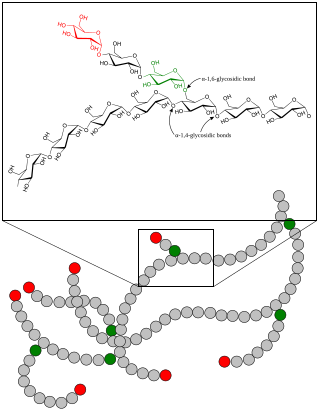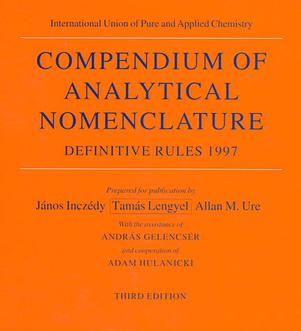Related Research Articles

The International Union of Pure and Applied Chemistry is an international federation of National Adhering Organizations working for the advancement of the chemical sciences, especially by developing nomenclature and terminology. It is a member of the International Science Council (ISC). IUPAC is registered in Zürich, Switzerland, and the administrative office, known as the "IUPAC Secretariat", is in Research Triangle Park, North Carolina, United States. This administrative office is headed by IUPAC's executive director, currently Greta Heydenrych.
In chemistry, the molar mass of a chemical compound is defined as the ratio between the mass and the amount of substance of any sample of said compound. The molar mass is a bulk, not molecular, property of a substance. The molar mass is an average of many instances of the compound, which often vary in mass due to the presence of isotopes. Most commonly, the molar mass is computed from the standard atomic weights and is thus a terrestrial average and a function of the relative abundance of the isotopes of the constituent atoms on Earth. The molar mass is appropriate for converting between the mass of a substance and the amount of a substance for bulk quantities.

In chemistry, an enantiomer – also called optical isomer, antipode, or optical antipode – is one of two stereoisomers that are non-superposable onto their own mirror image. Enantiomers are much like one's right and left hands; without mirroring one of them, hands cannot be superposed onto each other. No amount of reorientation in three spatial dimensions will allow the four unique groups on the chiral carbon to line up exactly. The number of stereoisomers a molecule has can be determined by the number of chiral carbons it has. Stereoisomers include both enantiomers and diastereomers.
Nomenclature is a system of names or terms, or the rules for forming these terms in a particular field of arts or sciences. The principles of naming vary from the relatively informal conventions of everyday speech to the internationally agreed principles, rules and recommendations that govern the formation and use of the specialist terminology used in scientific and any other disciplines.
In organic chemistry and biochemistry, a side chain is a chemical group that is attached to a core part of the molecule called the "main chain" or backbone. The side chain is a hydrocarbon branching element of a molecule that is attached to a larger hydrocarbon backbone. It is one factor in determining a molecule's properties and reactivity. A side chain is also known as a pendant chain, but a pendant group has a different definition.

In colloidal chemistry, flocculation is a process by which colloidal particles come out of suspension to sediment in the form of floc or flake, either spontaneously or due to the addition of a clarifying agent. The action differs from precipitation in that, prior to flocculation, colloids are merely suspended, under the form of a stable dispersion and are not truly dissolved in solution.
A chemical nomenclature is a set of rules to generate systematic names for chemical compounds. The nomenclature used most frequently worldwide is the one created and developed by the International Union of Pure and Applied Chemistry (IUPAC).
In chemical nomenclature, the IUPAC nomenclature of inorganic chemistry is a systematic method of naming inorganic chemical compounds, as recommended by the International Union of Pure and Applied Chemistry (IUPAC). It is published in Nomenclature of Inorganic Chemistry. Ideally, every inorganic compound should have a name from which an unambiguous formula can be determined. There is also an IUPAC nomenclature of organic chemistry.

In polymer chemistry, branching is the regular or irregular attachment of side chains to a polymer's backbone chain. It occurs by the replacement of a substituent on a monomer subunit by another covalently-bonded chain of that polymer; or, in the case of a graft copolymer, by a chain of another type. Branched polymers have more compact and symmetrical molecular conformations, and exhibit intra-heterogeneous dynamical behavior with respect to the unbranched polymers. In crosslinking rubber by vulcanization, short sulfur branches link polyisoprene chains into a multiple-branched thermosetting elastomer. Rubber can also be so completely vulcanized that it becomes a rigid solid, so hard it can be used as the bit in a smoking pipe. Polycarbonate chains can be crosslinked to form the hardest, most impact-resistant thermosetting plastic, used in safety glasses.

Quantities, Units and Symbols in Physical Chemistry, also known as the Green Book, is a compilation of terms and symbols widely used in the field of physical chemistry. It also includes a table of physical constants, tables listing the properties of elementary particles, chemical elements, and nuclides, and information about conversion factors that are commonly used in physical chemistry. The Green Book is published by the International Union of Pure and Applied Chemistry (IUPAC) and is based on published, citeable sources. Information in the Green Book is synthesized from recommendations made by IUPAC, the International Union of Pure and Applied Physics (IUPAP) and the International Organization for Standardization (ISO), including recommendations listed in the IUPAP Red Book Symbols, Units, Nomenclature and Fundamental Constants in Physics and in the ISO 31 standards.
In IUPAC nomenclature of chemistry, a pendant group or side group is a group of atoms attached to a backbone chain of a long molecule, usually a polymer. Pendant groups are different from pendant chains, as they are neither oligomeric nor polymeric.
In chemistry, coalescence is a process in which two phase domains of the same composition come together and form a larger phase domain. In other words, the process by which two or more separate masses of miscible substances seem to "pull" each other together should they make the slightest contact.

An Interpenetrating polymer network (IPN) is a polymer comprising two or more networks which are at least partially interlaced on a polymer scale but not covalently bonded to each other. The network cannot be separated unless chemical bonds are broken. The two or more networks can be envisioned to be entangled in such a way that they are concatenated and cannot be pulled apart, but not bonded to each other by any chemical bond.

Nomenclature of Organic Chemistry, commonly referred to by chemists as the Blue Book, is a collection of recommendations on organic chemical nomenclature published at irregular intervals by the International Union of Pure and Applied Chemistry (IUPAC). A full edition was published in 1979, an abridged and updated version of which was published in 1993 as A Guide to IUPAC Nomenclature of Organic Compounds. Both of these are now out-of-print in their paper versions, but are available free of charge in electronic versions. After the release of a draft version for public comment in 2004 and the publication of several revised sections in the journal Pure and Applied Chemistry, a fully revised edition was published in print in 2013 and its online version is also available.

The Compendium of Analytical Nomenclature is an IUPAC nomenclature book published by the International Union of Pure and Applied Chemistry (IUPAC) containing internationally accepted definitions for terms in analytical chemistry. It has traditionally been published in an orange cover, hence its informal name, the Orange Book.
The International Union of Pure and Applied Chemistry (IUPAC) publishes many books which contain its complete list of definitions. The definitions are divided initially into seven IUPC Colour Books: Gold, Green, Blue, Purple, Orange, White, and Red. There is also an eighth book, the "Silver Book".
IUPAC Polymer Nomenclature are standardized naming conventions for polymers set by the International Union of Pure and Applied Chemistry (IUPAC) and described in their publication "Compendium of Polymer Terminology and Nomenclature", which is also known as the "Purple Book". Both the IUPAC and Chemical Abstracts Service (CAS) make similar naming recommendations for the naming of polymers.
The Inorganic Chemistry Division of the International Union of Pure and Applied Chemistry (IUPAC), also known as Division II, deals with all aspects of inorganic chemistry, including materials and bioinorganic chemistry, and also with isotopes, atomic weights and the periodic table. It furthermore advises the Chemical Nomenclature and Structure Representation Division on issues dealing with inorganic compounds and materials. For the general public, the most visible result of the division's work is that it evaluates and advises the IUPAC on names and symbols proposed for new elements that have been approved for addition to the periodic table. For the scientific end educational community the work on isotopic abundances and atomic weights is of fundamental importance as these numbers are continuously checked and updated.

The International Union of Pure and Applied Chemistry (IUPAC) has published four sets of rules to standardize chemical nomenclature.
Chain scission is a term used in polymer chemistry describing the degradation of a polymer main chain. It is often caused by thermal stress (heat) or ionizing radiation, often involving oxygen. During chain cleavage, the polymer chain is broken at a random point in the backbone to form two - mostly still highly molecular - fragments.
References
- "Book details: Compendium of Macromolecular Nomenclature". IUPAC. Archived from the original on 2014-10-07. Retrieved July 6, 2012.
- "History of IUPAC Polymer Terminology and Nomenclature". IUPAC. Archived from the original on April 15, 2013. Retrieved July 6, 2012.